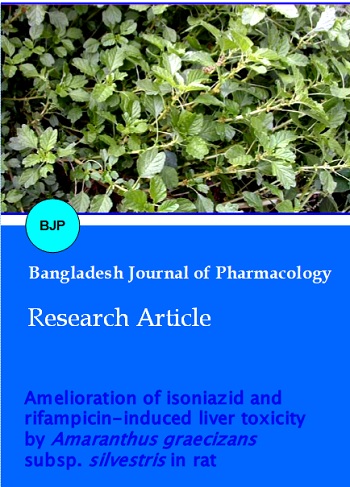Amelioration of isoniazid and rifampicin-induced liver toxicity by Amaranthus graecizans subsp. silvestris in rat
DOI:
https://doi.org/10.3329/bjp.v12i3.32985Keywords:
Amaranthus graecizans subsp. silvestris, Hepatoprotective, Isoniazid, Phytochemical, RifampicinAbstract
Amaranthus graecizans subsp. silvestris, a folk medicine for the treatment of inflammation, was used to evaluate its hepatoprotective potential against rifampicin and isoniazid-induced liver damage. Wistar albino rats were divided into four groups: Group I served as control (distilled water treated), Group II served as hepatotoxic group (isoniazid 50 mg/kg and rifampicin 100 mg/kg, treated), Group III served as positive control (silymarin 100 mg/kg, treated) while Group IV served as A. graecizans subsp. silvestris extract (400 mg/kg) treated group. The results suggest that the liver markers (alanine aminotransferase, aspartate aminotransferase, alkaline phosphatase and total bilirubin) were significantly increased in the animals of Group II. The methanolic extract showed a significant decrease in the raised liver enzymes of Group IV and encountered the liver damage caused by isoniazid and rifampicin. Histopathological examination of liver also revealed the improved architecture in the extract-treated group. Thus, the methanolic extract has potential liver protective action due to its phytochemicals.
Video Clip of Methodology:
8 min 24 sec: Full Screen Alternate
Downloads
109
108 Read
49

Published
How to Cite
Issue
Section
License
Authors who publish with this journal agree to the following terms:
- Authors retain copyright and grant the journal right of first publication with the work simultaneously licensed under a Creative Commons Attribution License that allows others to share the work with an acknowledgement of the work's authorship and initial publication in this journal.
- Authors are able to enter into separate, additional contractual arrangements for the non-exclusive distribution of the journal's published version of the work (e.g., post it to an institutional repository or publish it in a book), with an acknowledgement of its initial publication in this journal.
- Authors are permitted and encouraged to post their work online (e.g., in institutional repositories or on their website) prior to and during the submission process, as it can lead to productive exchanges, as well as earlier and greater citation of published work (See The Effect of Open Access).
